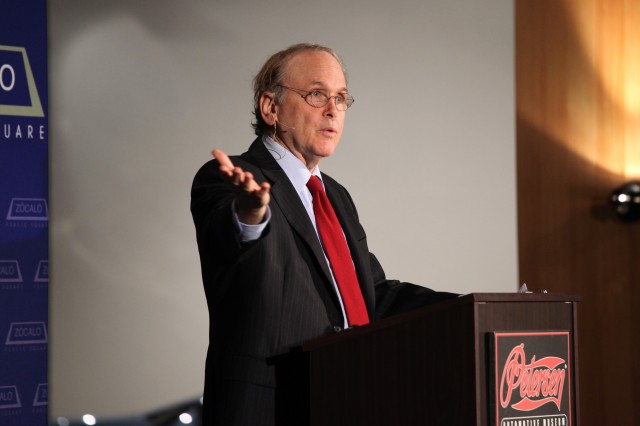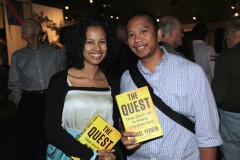
“What a great location for this evening’s discussion!” exclaimed Daniel Yergin as he opened his talk at the Petersen Automotive Museum. The setting was a room full of cars from the past century, and one of the main questions Yergin intended to address was “what kind of car we’ll all be driving in 20 or 15 years.”
Southern California was built on the automobile, Yergin told a packed room, but in the years after World War II, smog “laid siege” to Los Angeles. Yergin was raised in L.A. and recalled having trouble breathing as he rode his morning paper route. The smog problem was in part due to local topography. Native Americans called the area the “valley of smokes.” By the late 1940s, man-made contributions to air pollution had become so serious that Los Angeles was in crisis.

But no one knew exactly why, until California Institute of Technology chemist Arie Haagen-Smit stepped out of his lab in Pasadena one day to take a breath of fresh air, only to discover that there was nothing to breathe in except a stinking cloud of smog. He shifted the focus of his research to smog and quickly discovered the source: incompletely burned gasoline emissions. Cars, so central to the Californian way of life, were threatening to destroy it.
California’s government embarked on what would become a long campaign to reduce auto emissions. By the 1990s, the level of smog coming out of a car tailpipe had been reduced to only one percent of what it once was, and the quest for a zero-emissions vehicle–the electric car–had set the stage for what would become an epochal competition between the battery and the internal combustion engine.
It’s still too soon to tell whether the electric car will prevail, said Yergin. Even the most aggressive scenarios have them making up only a small part of the auto fleet by 2020. While there’s a lot of momentum, it will be five more years before we’ll know what the future will bring.
Yergin explained that he was drawn to the story of energy because it’s a story about foreign policy and economics, technology and politics–and fascinating people. Albert Einstein’s explanation of the photoelectric effect laid the groundwork for solar power; Thomas Edison spent years working on an electric car. After spending New Year’s Eve of 1981 atop a wind turbine in the middle of a blizzard in the Tehachapi Pass–desperately installing the machinery before tax credits ran out–Jim Dehlsen traveled to Europe and discovered the Danish wind machines that would become the backbone of California’s wind industry. And GE spokesman Ronald Reagan had an all-electric home that was a showcase for the technological transformation of the U.S. in the 1950s and 1960s.

The future of energy in the U.S. and the world hinges on balancing numerous priorities: economic growth and energy demand, energy security, and the health of the environment. The needs of emerging markets like China continue to grow, and energy consumption may double in two decades. Continuing instability in the Middle East (the source of 60 percent of the world’s oil resources) and other political threats, like cyber attacks, threaten our energy security.
Meanwhile, climate change is front and center in all discussions about the environment. But technology, and the power of innovation, will open up many possibilities for meeting our energy needs while protecting the environment, Yergin predicted. Efficiency is our biggest single new source of energy as a country, and the development of shale gas and Canadian oil sands and other new technologies also have great potential.
Yergin concluded that he doesn’t share the “doom and gloom” view of other energy experts. “I see a history of adaptation and innovation,” when it comes to energy, he said. And while the U.S. is still at the forefront of research and creativity, the globalization of innovation is expanding the possibilities for countries like China and India to develop new technologies of their own.

The quest for “the security [and] availability of energy for a prosperous world” is a quest that “is as much about human spirit as it is about technology,” said Yergin. “It is a quest that will never end and it is a quest that should never end.”
In a question-and-answer session, audience members asked Yergin to look ahead. While Yergin declined a request to predict the price of oil in 2025, he did voice a belief that demand will go down, even as “the price of oil will be determined by what happens with the world economy, what happens to technology.” While the world is not going to run out of oil, Yergin expressed concern about above-ground political and economic risks. What’s certain, though, is that oil companies are continuing to explore alternative sources of energy and the price of solar power is coming down–and the face of energy in 2030 will look very different from today.
Watch full video here.
See more photos here.
Read an excerpt from The Quest: Energy, Security, and the Remaking of the Modern World here.
Buy the book: Skylight, Amazon, Powell’s
Read expert opinions on the future of energy security here.
*Photos by Aaron Salcido.




Send A Letter To the Editors